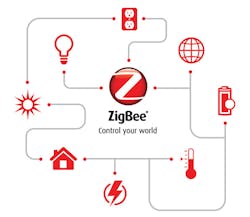This file type includes high resolution graphics and schematics when applicable.
The Internet of Things (IoT) continues to be a major talking point, as many look ahead to the connectivity it may bring to our world. However, an important question remains to be addressed: How will all of these IoT devices be wirelessly connected? Given the vast amount of IoT applications and requirements, it is certain that no single wireless technology by itself will be the driving force behind the IoT.
When investigating the technology options for IoT wireless connectivity, one cannot disregard cellular standards because they do figure to play a role. However, a number of other wireless technologies will likely have major involvement. In fact, vendors are already enabling IoT applications by offering products based on technologies such as ZigBee, Bluetooth, and LoRa. While we can expect to see much more wireless activity in the future as the IoT picks up steam, it is important to understand which aspects of current technologies make them such apt choices for the IoT.
ZigBee
At the forefront of the IoT is ZigBee, a standards-based wireless technology that is intended to meet the needs of device-to-device communications (Fig. 1). ZigBee has the advantage of being low-power, which means that it enables battery-operated devices to operate for several years. By using mesh networking technology, it also eliminates single points of failure. Another benefit of ZigBee is the standardization at all levels of the network, which allows devices from different vendors to work together seamlessly. ZigBee operates in the 2.4-GHz frequency band.
The ZigBee Alliance, which was established in 2002, is responsible for creating ZigBee standards. Its members come from all types of organizations all across the world. “The ZigBee Alliance is an organization of over 425 member companies that create, maintain, and deliver specifications, standards, and solutions for the wireless IoT market,” says Mark Walters, vice president of strategic development, ZigBee Alliance. “We provide and administer many different technologies ranging from simple low-cost, low-latency point-to-point technology ideally suited for consumer electronic remote controls (ZigBee RF4CE) to highly efficient and secure low-power mesh networking (ZigBee PRO) solutions to highly sophisticated and ultra-secure mesh networks based on Internet Protocols used by governments and utilities worldwide.”
The latest specification, ZigBee 3.0, was ratified in December 2015. Walters adds, “Our latest release is ZigBee 3.0, which is based on our ZigBee PRO mesh network. It incorporates all previously used application profiles into a singular, interoperable solution, thus making technology selection and market selection simple. The ZigBee Alliance provides complete end-to-end solutions, including the network specification or standard, the application layer and device definition, test plans and tools, and certification programs as well as branding and logo programs. This not only provides for powerful product solutions, but for interoperable market ecosystems as well.”
The large number of ZigBee certified products includes a multitude of home-automation and smart-energy products. “ZigBee-based solutions have been in the market for more than 12 years with continuous improvement throughout that time—and ship on the order of 400 million devices a year,” says Walters. “Advantages of ZigBee-based technologies/solutions include support from multiple manufacturers and suppliers.”
Recently, NXP Semiconductors—a member of the ZigBee Alliance—announced its new software development kit (SDK) for ZigBee 3.0. The NXP ZigBee 3.0 software is intended to be used with the company’s JN5169, JN5168, and JN5164 wireless microcontrollers, which are suitable for ZigBee and other IEEE 802.15.4-based network applications. The JN5169, for example, includes a 2.4-GHz transceiver, which comprises a 2.4-GHz radio, modem, baseband controller, and security coprocessor.
Bluetooth
Bluetooth low energy, also known as Bluetooth Smart or BLE, is a low-energy version of Bluetooth that is ideal for IoT applications. Its power efficiency allows devices to run for long periods of time via power sources like coin-cell batteries. “The IoT is likely to be founded on several wireless technologies, including Bluetooth low energy (also known by its consumer branding of Bluetooth Smart),” says John Leonard, product marketing manager at Nordic Semiconductor. “Bluetooth low energy is a proven, ‘ultra-low-power’ protocol based on an open standard and available from several major silicon vendors.”
However, Bluetooth low energy does have its pitfalls. Leonard notes, “Today’s Bluetooth low energy suffers a significant drawback as a technology for connecting ‘things’ directly to the internet. To make such a connection, contemporary Bluetooth low-energy devices require the resources of a sophisticated gateway, such as a smartphone or Wi-Fi bridge. For IoT implementations—where many millions of remote sensors are likely to be deployed—that is hardly a practical solution, as such gateways are expensive, bulky, complex, and demand a great deal of power.”
In the future, BLE devices may stand to benefit from Internet Protocol version 6 (IPv6). As a result, these gateways may no longer be required. “Tomorrow’s Bluetooth low-energy devices will take advantage of the Internet Protocol (IP) to make things much more practical,” explains Leonard. “IP defines how computers and other devices connected to the internet locate each other and exchange information. As the contemporary internet transforms into the IoT, many engineers suggest it will naturally adopt the latest version of the protocol, known as IPv6. A wireless IoT sensor supporting IPv6 will be able to communicate and exchange information with every other IPv6-enabled device without the resources of a gateway.”
Leonard adds, “The Bluetooth Special Interest Group (SIG) has made IP connectivity a little easier to implement with the introduction of the Internet Protocol Support Profile (IPSP) in Bluetooth Version 4.1. Communication between devices that support IPSP is accomplished using IPv6 packets over the Bluetooth low energy transport. Nordic Semiconductor is enabling Bluetooth low-energy devices with its nRF52 Series systems-on-a-chip (SoCs), which can now communicate with any other IPv6-enabled device. The company has helped developers working on IoT projects by offering the nRF5 SDK for IoT, which is a software development kit that incorporates a Bluetooth Smart software stack with an ‘IPv6 over Bluetooth Smart’ adaptation layer (6LoWPAN) and a complete Internet Protocol Suite (Fig. 2).”
Other suppliers of Bluetooth-based products include Silicon Labs, which recently unveiled its new Blue Gecko BGM113 Bluetooth Smart module. This module incorporates a 2.4-GHz Blue Gecko wireless SoC, a chip antenna, and the company’s Bluetooth 4.1-compliant software stack. Furthermore, the BGM113 delivers +3 dBm of transmit (Tx) output power and can cover a range as high as 50 meters. The BGM113 is well suited for a variety of applications, such as smartphone accessories, wearable sports and fitness products, wireless locks, and point-of-sale devices.
For its part, Telink Semiconductor offers its BLE series of Bluetooth SoC solutions, which includes the TLSR8263, TLSR8266, and TLSR8267 chips. Each of these devices features a 2.4-GHz transceiver and a single-pin antenna interface. The TLSR8263 provides +6 dBm of Tx output power, while both the TLSR8266 and TLSR8267 deliver +7 dBm of Tx output power. The company also provides a Bluetooth low-energy SDK and can deliver turnkey hardware reference designs to support fast product development.
Also sparking interest is Cypress Semiconductor, which recently launched its new CYBLE-224110-00 module. This new module supports BLE applications and includes an onboard power amplifier (PA), low-noise amplifier (LNA), crystal oscillators, chip antenna, passive components, and Cypress’ PSoC 4 technology. The CYBLE-224110-00 can deliver as much as +9.5 dBm of Tx output power while attaining a receive sensitivity of -95 dBm. Cypress Semiconductor also unveiled the CYBLE-222014-01 module to support Bluetooth Version 4.2.
LoRa Technology
ZigBee and Bluetooth are certainly not the only solutions that will enable the IoT, as a number of other wireless technologies are in the fray. One to keep an eye on is LoRa, which derives its name from its ability to enable “long-range” communications. LoRa is based on the chirp-spread-spectrum modulation format, which has the same low-power characteristics of frequency-shift-keying (FSK) modulation while providing increased communication range. Although the chirp-spread-spectrum technique has been used in military and space applications for a long time, LoRa is said to be the first commercial implementation.
LoRaWAN networks employ a star-of-stars topology and are designed to optimize the battery lifetime, capacity, range, and cost of low-power wide-area networks (LPWANs). These networks employ LoRa gateways, which are used to relay messages between the end node and the cloud-based network server. Such gateways are connected to the network server via standard IP connections, while end nodes use single-hop wireless communication to one or many gateways.
The LoRaWAN specification varies slightly from region to region. In North America, LoRaWAN networks operate in the industrial, scientific, and medical (ISM) frequency band from 902 to 928 MHz. In Europe, the frequency band from 867 to 869 MHz is utilized.
The LoRa product family from Semtech consists of several LoRa Transceivers along with the SX1301 digital baseband chip. The SX1272 LoRa transceiver covers a frequency range of 860 to 1020 MHz. It has three bandwidth options—125, 250, and 500 kHz—with spreading factors ranging from 6 to 12. The SX1276 transceiver spans a frequency range from 137 to 1020 MHz. Its bandwidth options span 7.8 to 500 kHz with spreading factors ranging from 6 to 12.
IoT Solution Providers
The aforementioned companies are not the only ones providing IoT-based solutions. GreenPeak Technologies (recently acquired by Qorvo) also offers technology solutions for IoT applications (Fig. 3), including various ZigBee transceiver chips.
Earlier this year, GreenPeak demonstrated its GP712 SoC for ZigBee and Thread networks. By combining both protocols, the company believes this solution can optimize the cost of connected-home applications. The GP712 covers a frequency range of 2400 to 2483.5 MHz, and can deliver +7 dBm of Tx power. It is intended for printed-circuit-board (PCB) designs using only low-cost components and printed antennas. The company also offers reference designs, development kits, software libraries, and production platforms.
In addition, Texas Instruments is doing its part to enable IoT applications. The company is accomplishing this by utilizing a number of wireless technologies including Wi-Fi, Bluetooth Smart, ZigBee, and more. One IoT-based product the company offers is the CC3200 single-chip wireless microcontroller unit (MCU), which consists of an applications microcontroller, Wi-Fi network processor, and power-management subsystems.
Obviously, the IoT will require the utilization of a number of different wireless technologies. In addition to those featured here, there are others such as Z-Wave, Thread, and SIGFOX, to name a few. In addition, others will surely emerge in the future, such as Wi-Fi HaLow, which the Wi-Fi Alliance plans to unleash in 2018. With all of that being said, it is clear the IoT landscape will require a number of technology solutions to satisfy the needs of so many applications. As the world becomes increasingly connected, we can expect to see more IoT devices from many suppliers with various wireless technologies being utilized. The IoT is still in the early stages, and it will be interesting to witness how everything unfolds in the weeks, months, and years to come.
Looking for parts? Go to SourceESB.
This file type includes high resolution graphics and schematics when applicable.




